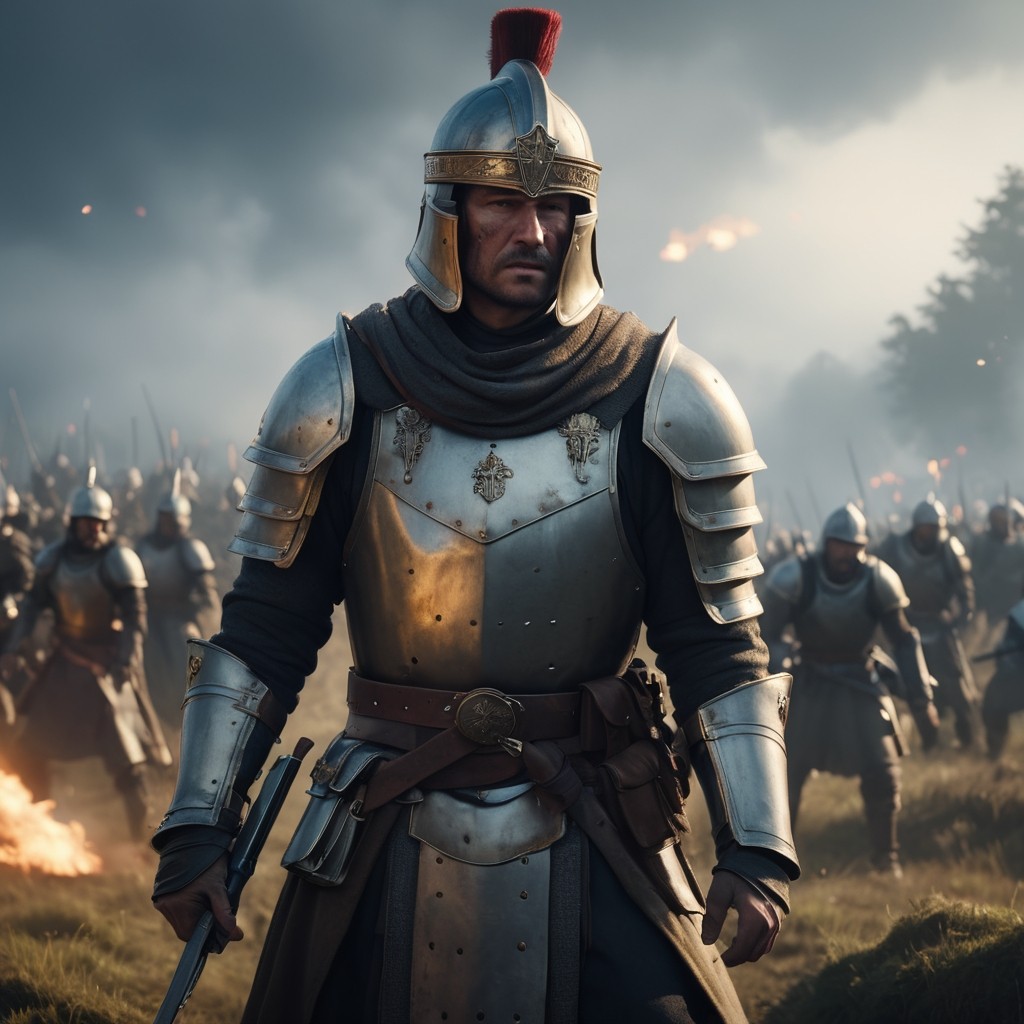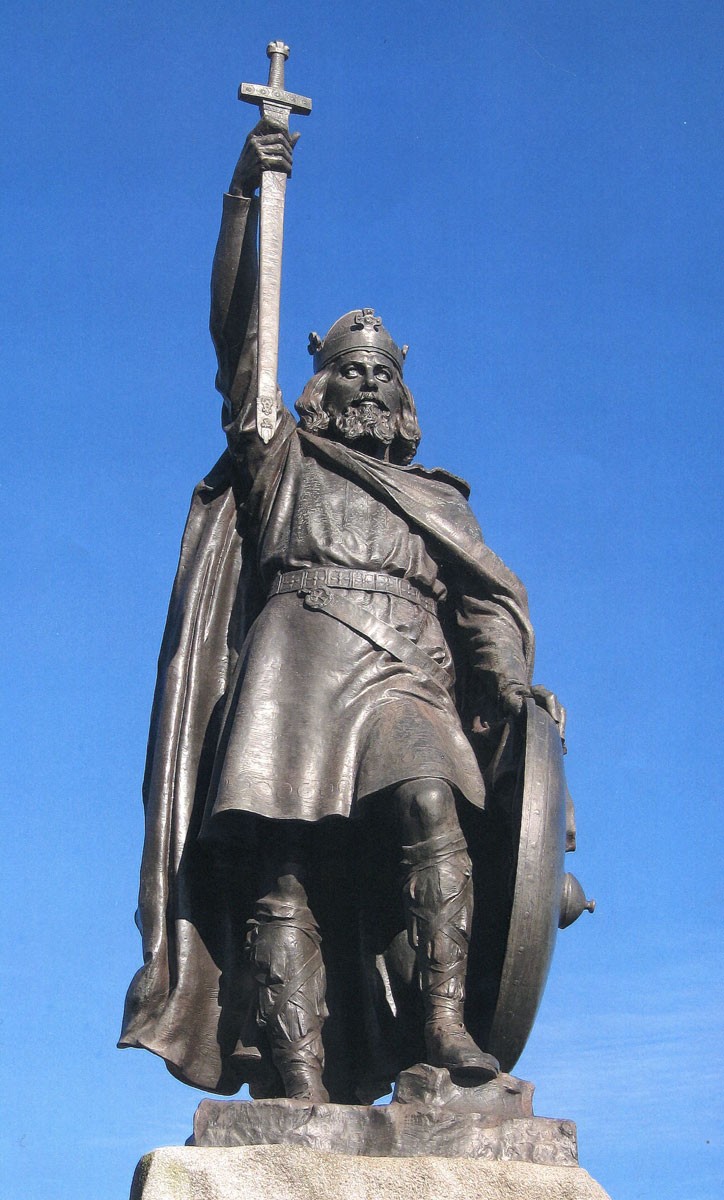
“Her cuom se here to Readingum on Westseaxe, 7 þæs ymb .iii. niht ridon .ii. eorlas up; Þa gemette hie Ęþelwulf aldorman on Englafelda, 7 him þær wiþ gefeaht 7 sige nam; Þæs ymb .iiii. niht Ęþered cyning 7 Ęlfred his broþur þær micle fierd to Readingum gelęddon, 7 wiþ þone here gefuhton, 7 þær wæs micel węl geslægen on gehwęþre hond, 7 Ęþelwulf aldormon wearþ ofslægen, 7 þa Deniscan ahton węlstowe gewald; 7 þæs ymb .iiii. niht gefeaht Ęþered cyning 7 Ęlfred his broþur wiþ alne þone here on Æscesdune, 7 hie wærun on twæm gefylcum, on oþrum wæs Bachsecg 7 Halfdene þa hęþnan cyningas, 7 on oþrum wæron þa eorlas; 7 þa gefeaht se cyning Ęþered wiþ þara cyninga getruman, 7 þær wearþ se cyning Bagsecg ofslægen; 7 Ęlfred his broþur wiþ þara eorla getruman, 7 þær wearþ Sidroc eorl ofslægen se alda, 7 Sidroc eorl se gioncga, 7 Osbearn eorl, 7 Fræna eorl, 7 Hareld eorl, 7 þa hergas begen gefliemde, 7 fela þusenda ofslægenra, 7 onfeohtende wæron oþ niht.”
An entry in the Anglo-Saxon Chronicle for 871, telling how the Viking Here, the Great Heathen Army, came to Reading and met Æthelwulf, the ealdorman of Englefield, and fought against him, achieving victory (sige). After four nights, King Æthelred and his brother Alfred gathered a great force (fierd) and fought against the Army, with much slaughter (micel wel geslægen) on both sides, leaving the Danes in control. Four nights later, Æthelred and Alfred clashed with the whole Army at Ashdown (Æscesdune) split into two groups, one led by Bagsecg and Halfdan, the heathen kings, and the other by the earls. King Æthelred fought fiercely against the kings' alliance, and King Bagsecg was killed; Alfred fought against the earls' coalition, with the elder earl Sidroc and the younger earl Sidroc, Osbearn, Fræna, and Harold all being slain. Both armies fled the battlefield, and thousands were killed, with fighting continuing through the night. (The 7 = and).
This bald entry in the Anglo-Saxon Chronicle relates the tale of a major event in British history, the battle of Ashdown. If the ‘Danes’ had won it would have been the end of Wessex and, therefore, the end of any possibility of a united Anglo-Saxon England, the likelihood of the whole British Isles being conquered by the Norsemen, and us speaking some form of Scandinavian.
The battle took place 1,154 years ago, on January 8, 871 AD, in Berkshire, and it is considered a pivotal moment in our history. It might even have significantly changed world history. England was then divided into rival kingdoms like Northumbria, Mercia and Wessex, each vying for power and control. It is thought that the invasion of the Great Heathen Army in 865 was the result of the killing of Ragnar Lothbrok, who had previously sacked Paris, by the Northumbrian King Ælla, who had him thrown into a snake pit. The invasion was led by Ragnar’s three sons, Ubba, Halfdan and Ivar the Boneless. It was certainly an impressive military operation, bringing parties of Norsemen from all parts of Scandinavia, France, Ireland and Pictland.
It soon began a period of sustained attacks on the Anglo-Saxon kingdoms, ultimately taking control of East Anglia and the southern part of Northumbria (Deira) centred on York. In response to this threat, Wessex and Mercia formed an alliance under King Aethelred of Wessex. Aethelred had two younger brothers, Alfred (later ‘the Great’) and Aethelwold, who both played significant roles in the battle.
The Great Heathen Army, led by King Bagsecg, had come to conquer and settle, not just to raid, and had set their sights on conquering Mercia and Wessex. On 28 December 870, The Army captured Reading and began to harry the local populace. A large raiding party was caught and defeated at the Battle of Englefield (Englafelda), which denied it supplies and emboldened the Anglo-Saxons. Under King Aethelred and his brother Alfred, the Anglo-Saxons marched on well-fortified Reading, only to be defeated there on 4 January 871. Aethelred and Alfred retreated northwest, with the Viking army under Halfdan and Bagsecg following them. They then took up formation on a ridge, giving them a distinct tactical advantage.
Despite being outnumbered and facing a ‘professional’, battle-hardened enemy situated on higher ground, Aethelred and Alfred, with their army of mainly farmers, approached the Viking camp and prepared for battle.
The Heathen Army was divided into two wings: one under Kings Halfdan and Bagsecg, the other under the Viking Earls. The Anglo-Saxon army also divided into two wings, Aethelred commanding one, Alfred the other.
As Alfred moved the Anglo-Saxon right wing onto the battlefield, Aethelred stayed in his tent to pray and hear mass with his priests, refusing to take the field until mass was finished. Alfred’s men were therefore in danger of being outflanked, so in a daring move, Alfred – only 22-year-old - formed a shield wall and charged uphill towards the Vikings. The fighting was intense, and it is said that the two sides fought for several hours, fighting hand to hand, almost eyeball to eyeball, with great slaughter on both sides. During the course of the battle, Alfred and Aethelwold led a contingent of troops around the Viking flank and attacked them from the rear, while Aethelred, his prayers finished, fought the front of the Heathen Army. This proved successful. The Viking, caught off guard and demoralised, were unable to recover. Sensing victory, Alfred rallied his troops and pursued the retreating Vikings, inflicting heavy casualties and securing a resounding triumph. The Viking army was defeated, and King Bagsecg and many of his warriors killed.
The Battle of Ashdown was a major Anglo-Saxon victory, though not immediately decisive. The war against the Vikings continued until 22 March, when they were finally defeated at the Battle of Meretun, where King Aethelred was mortally wounded. Because of his courage, leadership, tactical and strategic awareness, Alfred was automatic choice to replace Aethelred as King. (Anglo-Saxon kings were chosen.)
Under Alfred, the Anglo-Saxons continued to fight the Vikings with mixed success. In 872, he paid them to leave Reading and settle in London. It wasn’t until 878 that Alfred achieved the ultimate decisive victory over the Vikings, at the Battle of Edington, which secured the independence of Wessex and Mercia.
However, the Battle of Ashdown was a greatly significant victory. It established Wessex as the dominant Anglo-Saxon kingdom and set the stage for the eventual unification of the country. Alfred, as well as proving to be a highly competent military leader and a wise strategist, was also an inspirational figure on the battlefield. He fought, with immense personal courage, alongside his men, bolstering their morale and instilling a sense of purpose, motivating them to fight with unwavering determination.
He emerged as a beacon of hope for the English peoples. With his kingdom under constant threat, Alfred understood the importance of confronting the Vikings head-on to protect his people and preserve England’s independence. Ashdown laid the foundation for Alfred’s future successes, eventually leading to his status as one of England’s most revered monarchs, the only one of our monarchs entitled ‘The Great’.
If Ashdown had been lost, England would probably have been lost followed by the whole British Isles, all likely to have come under Viking domination,forming a sort of greater Scandinavia, and us now speaking something like Icelandic.
And it is very likely, in my opinion, that the course of world history would have been different with a Norse Britain. Perhaps Christianity would never have got a foothold again, or if it did it might have been the Irish, not the Roman variety, and instead of the emotional ties and cultural cringe the upper classes have for France resulting from the Norman Conquest, it would have been to Denmark, creating a very much stronger Germanic v Latin tension in Europe.
Perhaps, with the much bigger numbers a Norse Britain would have resulted in, the British Norse would have followed the Vikings to North America several hundred years before Columbus, settling there to found colonies. Or maybe to sail down Russia’s rivers to found cities like Kiev that would remain Germanic, instead of Slavic. Who knows, they might even have got to Constantinople first and kept the Turks out.
